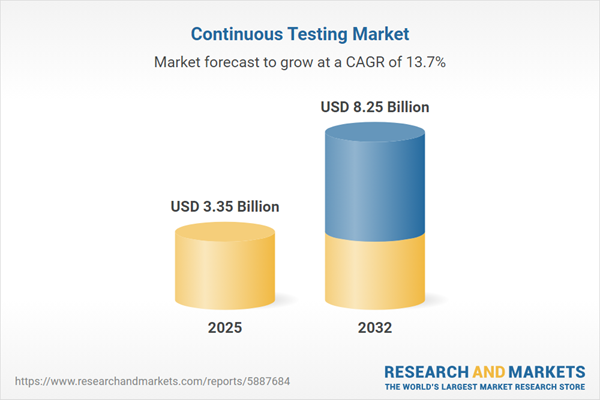Speak directly to the analyst to clarify any post sales queries you may have.
The continuous testing market is witnessing robust momentum as enterprises accelerate digital delivery while rigorously maintaining software quality. Senior decision-makers are prioritizing strategies that seamlessly balance rapid innovation with risk mitigation, leveraging continuous testing as a critical component of their DevOps toolchains in today’s evolving technology landscape.
Market Snapshot: Continuous Testing Market Growth and Opportunity
The Continuous Testing Market grew from USD 2.94 billion in 2024 to USD 3.35 billion in 2025 and is projected to expand at a CAGR of 13.73%, reaching USD 8.25 billion by 2032. This strong trajectory highlights rising enterprise adoption of automated validation and agile development methodologies, underscoring how essential continuous testing has become for organizations competing in digital-first environments.
Scope & Segmentation: Full Coverage of the Continuous Testing Ecosystem
- Testing Types: Compatibility Testing, Functional Testing, Performance Testing, Security Testing, Usability Testing.
- Automation Level: Automated (covering both Commercial and Open Source solutions), Manual Testing.
- Deployment Models: Cloud (encompassing Private Cloud and Public Cloud), Hybrid (including Multi-Cloud Hybrid and Single-Cloud Hybrid), On Premise deployments.
- Application Types: Desktop Applications, Embedded Applications, Mobile Applications (including both Android and iOS), Web Applications (covering E-Commerce and Enterprise use cases).
- Organization Size: Large Enterprises, Small and Medium Enterprises.
- Industry Verticals: Automotive and Manufacturing, BFSI (Banking, Financial Services, Insurance), Healthcare (covering Hospitals and Pharmaceuticals), IT and Telecom, Retail and E-Commerce (both Offline and Online channels).
- Regional Coverage: Americas (North America and Latin America), Europe, Middle East & Africa, and Asia-Pacific. Key countries include the United States, Canada, Brazil, United Kingdom, Germany, United Arab Emirates, South Africa, China, India, Japan, Australia, and others.
- Leading Companies Analyzed: Tricentis GmbH, Broadcom Inc., Micro Focus International plc, IBM Corporation, SmartBear Software, Parasoft Corporation, Keysight Technologies, Inc., Sauce Labs, Inc., Ranorex GmbH, Applitools, Inc.
Key Takeaways for Decision-Makers
- Continuous testing enables faster defect detection and supports a culture of ongoing improvement across development teams.
- Automation integration, including machine learning for test generation, helps shift testing left and reduces rework.
- Cloud-native architectures and containerization are fueling flexible, scalable approaches that easily adapt to complex systems and varying environments.
- Integrated security validation is now essential, as vulnerabilities must be identified as early as possible within the pipeline.
- Open source frameworks provide cost-effective options, especially as software vendors contend with supply chain and regulatory uncertainties.
- Strategic focus on interoperability and ecosystem alignment ensures solutions remain adaptable and future-ready within rapidly changing IT landscapes.
Tariff Impact: Responding to Shifts in the Global Technology Supply Chain
Recent US tariff changes have prompted organizations to re-evaluate technology sourcing for continuous testing, particularly for on-premise hardware and specialized network equipment. Many teams are shifting to cloud-based testing environments to offset tariff-driven cost fluctuations. The move towards virtualization, containerization, and open source testing frameworks is rising in response to supply chain pressures and cost management objectives. This approach enhances agility and operational resilience even in the face of uncertain trade policies.
Methodology & Data Sources
This report is based on a multi-phase research methodology, combining in-depth secondary research with primary interviews of senior quality assurance, DevOps, and infrastructure experts. Quantitative surveys and triangulation with financial disclosures and industry publications ensure reliable, actionable insights into continuous testing market dynamics.
Why This Report Matters
- Provides senior leaders with a comprehensive framework to tailor testing strategies by segment, technology, and region.
- Enables informed investment decisions, aligning tooling and process choices with organizational risk, compliance, and performance priorities.
- Highlights market dynamics and innovation drivers critical to accelerating transformation and securing quality outcomes across the software delivery lifecycle.
Conclusion
Continuous testing is central to building quality, resilience, and speed in software development. Senior leadership can use these insights to steer technology investments and adapt to ongoing ecosystem shifts. Applying these findings optimizes strategic planning for superior digital delivery outcomes.
Additional Product Information:
- Purchase of this report includes 1 year online access with quarterly updates.
- This report can be updated on request. Please contact our Customer Experience team using the Ask a Question widget on our website.
Table of Contents
3. Executive Summary
4. Market Overview
7. Cumulative Impact of Artificial Intelligence 2025
Companies Mentioned
The companies profiled in this Continuous Testing market report include:- Tricentis GmbH
- Broadcom Inc.
- Micro Focus International plc
- IBM Corporation
- SmartBear Software, Inc.
- Parasoft Corporation
- Keysight Technologies, Inc.
- Sauce Labs, Inc.
- Ranorex GmbH
- Applitools, Inc.
Table Information
| Report Attribute | Details |
|---|---|
| No. of Pages | 188 |
| Published | October 2025 |
| Forecast Period | 2025 - 2032 |
| Estimated Market Value ( USD | $ 3.35 Billion |
| Forecasted Market Value ( USD | $ 8.25 Billion |
| Compound Annual Growth Rate | 13.7% |
| Regions Covered | Global |
| No. of Companies Mentioned | 11 |









